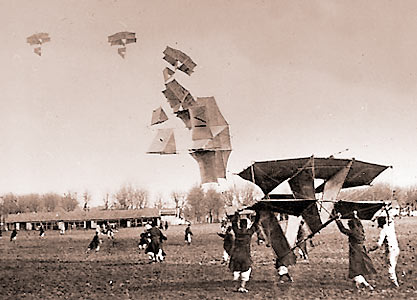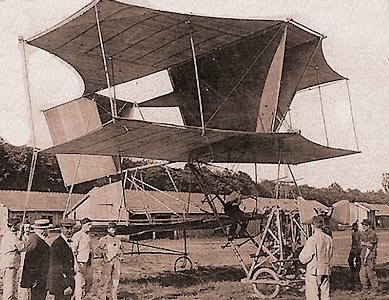
|
| |
| |
|
|
| Military development of the kite |
|
| |
|
|
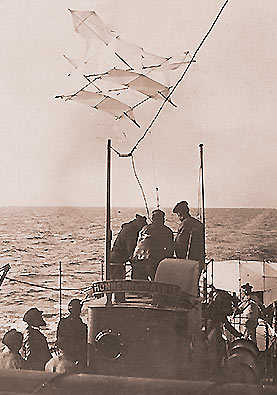 |
War Ministries of the various European countries offer considerable budgets for the development of the kite.
In 1902, Captain Saconney obtained the upper Aeronaut licence and becomes expert balloonist. At the request of the Navy Minister, he is detached in 1902 to serve aboard a destroyer of the North squadron, to attend telephotography experiments off the coast of Rochefort. (photo left
Initially, he experiments with a kite system capable of carrying a camera that allowed establishing a mapping of the coast. (photo right)
Aerial photography by kite wasn't a secret anymore in those days, thanks to the work of Arthur Batut and Emile Wenz, but Saconney will imprint it with his scientific strictness. (see the Kite History Aerial photography on Wokipi website)
Hanging the camera properly and triggering the shutter remains a problem though. In Russia, up to 4 simultaneous shots have been taken. As soon as May 1904, many ships are equipped with sets of kites to allow ascensions, as well as wireless telegraph experiments and photography.
In 1908, Saconney made six months experience on board destroyers. he employs and examines kites of all types. He sailed in the Mediterranean aboard the Battleship Saint Louis to improve the settings of the kite and the photographic technique then aboard the battlecruiser Kléber.
In 1908, France is in conflict with Morocco. Captain Saconney 's kites are used to raise radio antennas, allowing transmissions between Morocco and Eiffel tower.
|
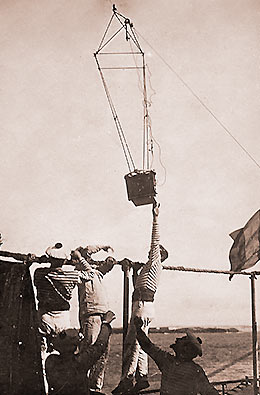 |
| |
|
The first trials of Saconney 's kites occur at fort d'Alpeck, near Boulogne sur Mer, where Misses Saconney is offered, on December 25th 1909, the pleasure of the first human ascension as a Christmas gift… (photo right)
A journalist, Jacques Altazin, depicts this event in a report on January 10th : "… the Alpeck point, very high above the sea level, beaten by high sea winds and ascending winds along the cliff, is a test site offering all possible difficulties together, due to the irregularity and unsteadiness of the wind. In spite these difficulties, Captain Saconney patiently and learnedly tuned his apparatuses (…)
The train consists of only 5 kites. Captain Saconney rose in company of Misses Saconney with the greatest ease, which make a total of 150 kilos carried by the kites. We figure what services may, in times of conflict, these mounted apparatuses provide as watch towers and wish to see their use generalized in the Army".
The aerial meetings
During the years preceding the Great War, great aerial meetings are organized all over the world. During the years preceding the Great War, major air shows are organized around the world. June 25, 1903, the "British Royal Aeronautical Society" organizes a meeting involving balloons and kites in Sussex. Included are Kite flyers renowned as Samuel Cody, Charles Brodgen, Baden-Powel and Salmon. Sometimes civilians are part of the contest, hoping to see their inventions used by the army.
Captain Madiot begins his experiments in 1907, at the Belleville fort, near Verdun. In 1908, he achieves a flight a few meters above the ground, sitting on a simple plank attached to his kite. After that, he will use a cylindrical nacelle made of canvas stretched on a frame. On October 17th, 1909, he reaches an altitude of 100 meters. This exploit made a lot of noise. During the visit of the Chinese delegation to the camp, in Chalons, he is able to climb to 300 meters. |
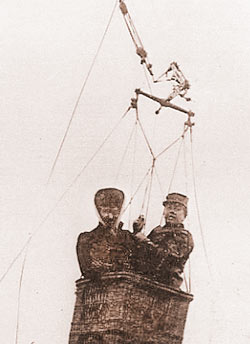 |
| |
Dolfus' contest
In 1909, under the patronage of the 'Ligue Nationale Aerienne', the commander of Territorial Army, Dolfus, organizes a "mounted kite" contest, with a prize of 10 000 francs. The main conditions of this contest consist in presenting a mobile and transportable gear, allowing to raise an aeronaut to a height of at least 300 meters with a wind of at least 10 meters per second (the limit for captive balloons). The nacelle must stay at least 15 minutes aloft, without taking the ascension and descent in account. In this contest, the only inventor having a machine satisfying most of these conditions is artillery captain Madiot. The madiot kite is a Hargrave model with ailerons, built to manoeuvre with light wind (between 6 and 11 m/s). They are hooked together "the Russian way"; the cable running through the kites. (photo right below)
|
| |
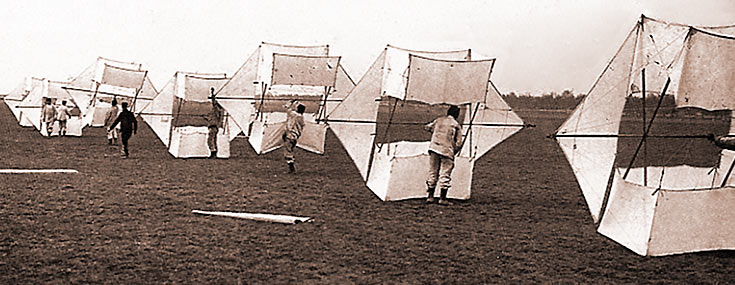 |
|
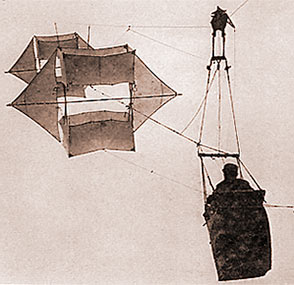 |
| |
Reims' Contest
Between July 3 and 10th 1910, during the aviation week, two days are devoted to kite contests, with a 7000 Francs first prize and a 3 000 Francs second prize; these are golden francs of that period. An article of the "Aviator" journal mentions : ".. it is with a deep surprise that we saw, around three o'clock in the afternoon, captain Madiot launch his train of 8 kites in the sky (photo left below)… He remained in his observatory, hung to the clouds, for more than an hour…"
Unfortunately, captain Madiot dies in a Bréguet military aeroplane on Octobre 23, 1910 at Brébières. This catastrophe interrupts a series of successes that gave so much hope, but guarantee at least to captain Madiot a leading place among pioneers of kite ascensions. |
| |
| |
|
On his side, Captain Dorand is interested in telephotography; he contributes to the stability improvement of observation kites. He sent a report about his experiments to the ministry of war. The goal of his studies is to apprehend the launch facilities of carrying kites, the conditions under which they can raise a nacelle loaded with the weight of a man. Later, he will contribute to aviation's evolution. Indeed, in 1908, he flies a strange aero plane whose design is very close to his kites.
Above : launch of one of captain Dorand's kite trains. On right : his military airplane in Satory Camp (Versailles) |
| |
|






